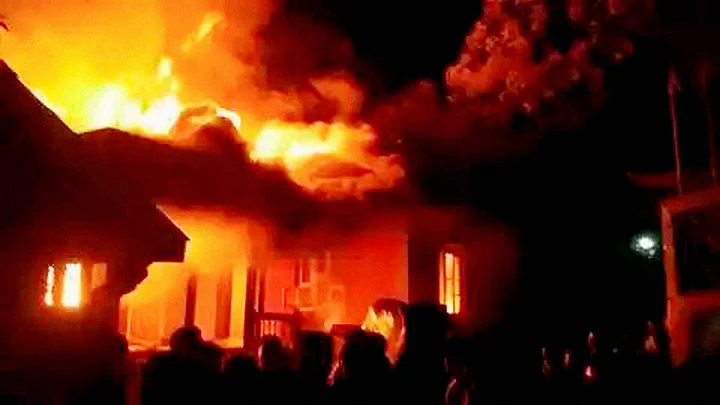Us vs Them
- The Meiteis of Manipur want protection against alleged “outsiders”, even as Manipur’s non-Meiteis speak of Meitei domination
- Manipur’s alleged “migrant” population is almost the same in number as the Meiteis within the state
- Beyond Manipur too, hitting out at “outsiders” is an alibi for any ethnic group competing for ascendancy
- Ethnic groups across the Northeast are “re-inventing identities” and “reinterpreting history” to suit themselves
Manipur Crisis
The recent incidence of violence in Manipur over the Meitei demand for an Inner Line Permit system is one among the many inter-community conflicts affecting the Northeast. Supporters of Inner Line Permit (ILP) system want to protect “insiders” from the unregulated entry of “outsiders” especially in context of buying land in the region.
Minority communities in Manipur, such as the Kukis allege that three laws passed by the Manipur Assembly last week are an attempt by the majority community, the Meiteis, to occupy land in state’s hill districts, that had previously been “protected”.
The Meiteis on their part, are demanding protection of land in Manipur’s valley areas, against “outsiders” given that their numbers are almost the same as the Meitei population within the state.
The Meiteis contend that while other tribal communities in Manipur can buy land in the Manipur valley (that is just 10% of the state’s land, the rest are hills), the Meiteis cannot buy land in the hills.
Myopia in the North-East
The current crisis in Manipur over the imposition of a colonial era law, the Inner Line Permit, raises fundamental questions around rights of citizens in the region.
The Indian government’s ‘north-east policy’ if there is one at all, has largely been one of fire fighting and responding to the sub national aspirations of various groups, some of whom have been aggressive and militant.
While the policy has failed to address any of these grievances, it has also failed to recognise that along with the ‘indigenous’ groups there are millions of other bonafide citizens whose rights are trampled every day across the region.
‘Outsider Vs Insider’ in Assam
During the six years of the Assam movement between 1979 to 1985 (against “foreigners”) the relationship even within “indigenous” groups ruptured. This is because labels such as “Bangladeshis” and “foreigners” were commonly used for legitimate citizens. This not only polarised the ethnic Assamese with other non-Assamese communities but also divided them from tribal groups such as the Bodos.
In fact terms like “ethnic-Assamese” emerged out of this movement because of a certain hegemony that other groups perceived. Eventually, those groups too started asserting their rights.
This in short has been the contemporary history of the region; groups pitted against each other for greater turf, greater rights. However, what has been shadowed in this circus of ethnic wars is the terrible tragedy of the so called “outsiders” who have been settled in these parts for over a century or more. Identities were invented and reinvented and history interpreted to suit each group.
But Who is an “Outsider” Really?
The Gorkha community settled for nearly two centuries in Manipur are “outsiders” today. Incidentally, the first batch of Gorkhas came to Manipur during the time of Raja Gambhir Singh in 1824, to fight Burmese invaders. The militia was named the ‘Victoria Paltan’.
The same would hold true in other states. Assam’s greatest cultural icon, Jyoti Prasad Agarwala was a Marwari, technically an “outsider”.
Assam as a colonial province was formed in 1874. Prior to that it was ruled as a province of Bengal. In the new arrangement, East Bengali district of Sylhet was also included in Assam. Naturally Bengalis were part of this province. But the Partition saw massive refugee influx from East Pakistan. And so, since the ‘50s, intense anti-Bengali movements engulfed Assam culminating in the epic Assam agitation.
After the creation of Bangladesh, another wave of migration was witnessed and a continuous trickle followed through the decades threatening the demography of the state and the region. But chauvinistic campaigns were directed towards all Bengalis that later morphed against all “outside” communities that had settled in the state. Hitting out at “outsiders” became an alibi for any pressure or political group trying to gain legitimacy. There have been very feeble attempts to document and analyse this xenophobia.
‘Outsider’Phobia in Meghalaya
Meghalaya for more than a decade since 1979 witnessed barbaric genocide where “outsiders” were systematically removed in name of tribal rights. The first target were the Bengalis, then the Nepalese and soon all “non-tribals” were targeted. Several hundreds had to flee overnight. There are no records in any police stations in Meghalaya of this decade of violence.
The gruesome murder of Gauri Dey raped and killed by her neighbours in front of her husband tied to a post remains perhaps the only telling memory of the bloodied years. Today certain groups in Meghalaya are demanding an Inner Line Permit. After driving away hundreds and thousands of families, what could possibly be their fear? And in this demand, they recently managed to kill two “outsiders” as well.
Crisis often leads to opportunities. If this decades-long crisis has to be resolved, the nation needs to debate the constitutional right of “single citizenship” and the limits of “indigenous rights”.
One’s right cannot be granted at the cost of denying another’s. The post independence story of this region has been a grave violation of human rights of citizens labeled as “outsiders”. Perhaps addressing this violent “othering” may help resolve several such movements simmering not just in the North-east, but across the country as well.
(Kishalay Bhattacharjee is a senior journalist and Director, Reachout Foundation. His book Blood on My Hands: Confessions of Staged Encounters, published by HarperCollins India is being released in September 2015)
